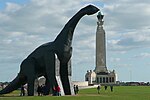Portsmouth High School, Southsea
1882 establishments in EnglandEducational institutions established in 1882Girls' schools in HampshireMember schools of the Girls' Schools AssociationPeople educated at Portsmouth High School (Southsea) ... and 4 more
Private schools in PortsmouthSchools of the Girls' Day School TrustSecondary schools in PortsmouthUse British English from February 2023

Portsmouth High School is a private day school for girls in Southsea, a district in the southern coastal city of Portsmouth, England. Founded by the Girls' Public Day School Trust in 1882, it is one of the Trust's smaller schools. The Good Schools Guide described the school as "a super no-frills choice: big enough to appeal to almost any girl, but not at the expense of the personal touch".
Excerpt from the Wikipedia article Portsmouth High School, Southsea (License: CC BY-SA 3.0, Authors, Images).Portsmouth High School, Southsea
Kent Road, Portsmouth Southsea
Geographical coordinates (GPS) Address Phone number Website External links Nearby Places Show on map
Geographical coordinates (GPS)
| Latitude | Longitude |
|---|---|
| N 50.788 ° | E -1.094 ° |
Address
Portsmouth High School (Senior School and Sixth Form)
Kent Road 25
PO5 3EQ Portsmouth, Southsea
England, United Kingdom
Open on Google Maps









